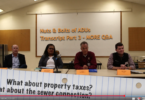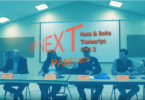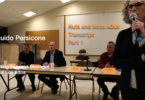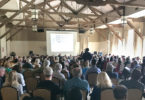THE MALADY – All the most recent zoning ordinances, roll-backs, and building moratoriums in the City of Los Altos seem to be ineffective in balancing desired housing growth & vibrancy with our ineffable ‘village character.’ Our prior Housing Element plan in the General Plan has not been in compliance with State Housing and Community Development requirements. It has been a fantasy that the City could meet its Regional Housing Needs Allocation for affordable housing with its prior policies. Is it time for an El Camino Specific Plan?
Los Altos City Council members seem to be unhappy with the recently crafted Los Altos Density Bonus ordinance. Jan Pepper said it might be better to scrape the ordinance with its “menu” system of “developer concessions” for affordable housing and instead just use the state law version. In her opinion, the latest iteration of the Sorensen project on Main Street sought to “double dip” some of the Los Altos ordinances menu items. [Council voted unanimously to deny the 57-foot mixed-use plan which included some BMR units. The ordinance has also been used by developers with multi-story projects on El Camino.
And now there are numerous residents asking for zoning reforms for the CT zone – El Camino Real. The request is for an El Camino Specific Plan that would preserve some walkable retail. Fred Haubenseck – who resides near Whole Foods – has led his neighbors in asking that Los Altos take a look at Mountain View’s El Camino Specific Plan.
Lalahpolitico: And while the City is working on an El Camino Specific Plan, perhaps include a redo of the out-of-date Sherwood Specific Plan from the 1990’s! [The Chef Chu triangle.] And study the problem of lack of a mid-density tier “buffer zone” between high-rises and single-family homes in some areas of El Camino. Maybe the very unlikely to pass SB50 could ‘help’ with the establishment of a buffer zone, ‘thanks’ to its provision for conversion of single-family homes to fourplexes!
TRANSCRIPT OF A PRESENTATION
El Camino 2.0 in Mountain View
THE CURE – On Thursday, May 9 the City of Mountain View held a presentation about “El Camino 2.0.” It was about the progress of that city in providing significant new housing and transit improvements. There were 4 presenters – but this post focuses on the remarks of Rick Williams of Van Meter Williams Pollack LLP. His talk was primarily about Affordable Housing and Market Rate Housing including that in Mountain View’s El Camino Specific Plan.
With all our ineptness with zoning, Los Altos seems to be in dire need of the consulting services of his firm or a similar firm with experience in affordable housing! – Lalahpolitico

Van Meter LLC clients
Here follows a transcript of Williams’s remarks edited for clarity.
We have 35 years of experience working with cites along El Camino Real from Daly City to San Carlos to the City of Santa Clara. We are working with the urban planners – Aramis Associates – on the El Camino Specific Plan for Santa Clara and also the one Mountain View.
But we are also architects. So what we do is help all the cites write the rules around how to do development in their community, and then we come in later on and ask for ways to break all those rules.
On any parcel, it is hard to change from a current built-out density and transition to another density build-out. It’s a big challenge in creating the right policy rules and regulations. The most difficult thing to do is what Santa Clara is looking at – going from a strip mall shopping centers to having ground floor retail with parking behind it and a mix of housing for its El Camino Specific Plan.
Different developers do different kinds of development. So how to proceed forward across a variety of land use transitions can have diverse approaches and strategies.

It’s hard to transition from one land use to another per Van Meter LLC
All these different cities from South San Francisco to Santa Clara have had El Camino Specific Plan initiatives. They’ve all been rewriting plans for the El Camino corridor and have all done so in interesting ways. They all have unique community characteristics. They all have their own rules and priorities. All these cities are little incubators. They test things in different ways. Eventually one can figure out which ones work best. Followers try to apply that.
The fun part of working in Mountain View is that they’ve been a leader in planning along the El Camino for many, many years. And they’ve also been leaders in planning for their downtown and other parts of their community.

Different projects do share similar sidewalk arrangements…per Van Meter LLC. All residential, or mixed use with ground floor retail, all using a similar formula for sidewalk treatments.
The Same, But Different
Lots of cities look at what Mountain View has done with its El Camino Specific Plan. But South San Francisco has their own take on it. Palo Alto had its own take on it. Santa Clara will have its own take on it. We’ll see different decisions being made. We’ll see which ones bear the most fruit over time.
You can look at 2 or 3 different aerials from 2 or 3 different communities and they start to all look pretty much the same. There are strip shopping centers. There are large retail centers which are probably going to last a lot longer because they are fairly successful neighborhood centers. There are others that are kind of mid-sized. There are office buildings with some parking. And there are a whole series of little tiny parcels that actually are a really big opportunity for affordable housing in future years. They will add diversity in character to all the development going on.
One of the pressures I’ve been hearing when I stand before the various city design review boards is “Why is everything starting to look the same?”
Well, there are formulas around these things. We are looking at the ways you can approach different types of parcels and different cities. And everybody has their own strategy for thiere El Camino Specific Plan. So whether it is an old motel, a small commercial or industrial facility, an outmoded retail center, or a regional retail center, you need to do different things to each of those types of sites when you are thinking of the development along El Camino Real.
These various types and sizes of sites along El Camino Real will create wide diversity in [housing] projects. But they may all share some fundamental principles. There will be residential stoops on the street to provide active uses, with street trees, lighting, and with a little separation between the stoops.
If a project includes commercial uses, like this brand new development in Redwood City, there will be trees, lighting, new entries, with some housing above.
Here’s some affordable housing in S. San Francisco, with a little bit of commercial on the ground floor which they have been struggling to fill for as long as I can remember. The tenant did a wonderful job in filling the housing though.
Next to that building is a market rate development, and the one in between has 25% affordable units. The projects are diverse but carry along some similar architectural principles. The sidewalk sections are essentially the same.
EXPLORE THREE TYPES OF SITES
LARGE
Let’s look at the larger sites, which have been retail for many many years where the centers have died. This is new development that has been under construction, just finishing up, with housing in the back and over here a little bit of housing and office, then a predominantly retail space, with an internalized public park/realm space. The entry gateway is Santa Clara.
This one is Redwood City. This is part of a whole area that has been redeveloping. Notice that the building here also has a step back at a certain height. It’s lower in the front, they have the same third floor, where they then set back to change the view plane. So there are a lot of principles that are similar.
On the larger sites, they often try to break up the parcel into different street configurations so that it becomes a series of lots. This one is still mostly a superblock type of development. In essence, it is cutting the parcel in half, in the front retail and in the rear residential development.
For a large project, a national developer would want it to be 200 to 300 units. 200 to 250 is the sweet spot. For this scale, they are looking for 2.5 or 3 to 4-acre sites.
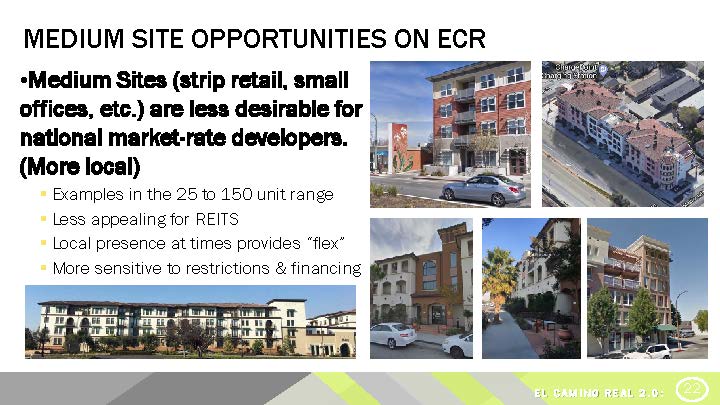
MEDIUM
The medium size sites are actually the bread and butter of the major part of the development community. These sites range from 25 to 150 units.
When you are at the medium scale, you get a very interesting collage of developers. You get more local developers that are more connected with the community. They sometimes understand the community better.
But there is more stress from a financial institution lending standpoint. The medium developer and their projects are not as appealing to the major REITs.
A city might get a little more design flexibility from the medium developer. You are getting local developers that understand how to get through the local process. They are a little more sensitive to a city’s restrictions. But they are more cost sensitive and have a more difficult time bringing their projects to fruition because of their financial limitations.

SMALL
The small sites are kind of a ‘land banking’ on El Camino for the 100% Affordable Housing projects. One of the things we talked about when we were doing the Precise Plan for El Camino in Mountain View was that you really need a different set of regulations for small parcels because with set backs and transitions, you have a harder time maximizing the development potential of the site. [Making it pencil out.] One of the things that AH does is that it allows a developer significant concessions. A city can refine those concessions for 100% AH projects while limiting the concessions market rate developers can use. In that way, on small sites with an AH project, you get a wider variety of design solutions.
The small sites are almost informal land banking. The smaller parcels are ideal for AH. They are going to be in the 50 to 100 units range, using the extra concessions to achieve that overall goal.
This development here is a good example of that. The building is set back but does not meet all the local regulations, but then it uses the State Density Bonus Law.
What are the big issues on El Camino
Now and in the FUTURE?

Political backlash
We have to be prepared for the political backlash in reaction to all the development that has been happening when an El Camino Specific Plan unfolds. I am sensing it every time I go into the community. People are getting construction tired.
Sensitive to SFH neighborhoods
We really have to retain this architectural focus of stepping back higher floors and transitioning of projects from surrounding single-family neighborhoods.
Retaining some Retail in El Camino Activity ‘Nodes’
The challenge is that this change of land use policy from a linear El Camino [retail strip] to a nodal El Camino [nodes of retail activity in between blocks of residential] may or may not take place. I think the nodal pattern will occur naturally, but the retail nodes may not always occur where everybody wants them to be.

The naturally occurring retail activity nodes – here called defined activity centers – may or may not occur as we would prefer.
Waiting for Small Biz to Retire and Sell
The existing small businesses along El Camino are losing their auto-oriented environment. That’s going to transition over time as people retire. Most of the people who have the small businesses own those buildings. So when they retire, they are going to be selling those small parcels. Hopefully, they will look to sell to a non-profit developer that wants to build affordable housing.
Cites have a Sales Tax Addiction
One of the biggest challenges – and we are grappling with this in Santa Clara, Daly City, and others with tight budgets — is that cities have a real reliance on the sales tax revenue. In Sunnyvale, 80% of their El Camino Specific Plan area, is zoned commercial. And that zone there reaches ¼ mile in from each side of El Camino. They think of all that land as sales tax potential, even if is a marginal retail site. They really think that eventually, it could be bigger and better.
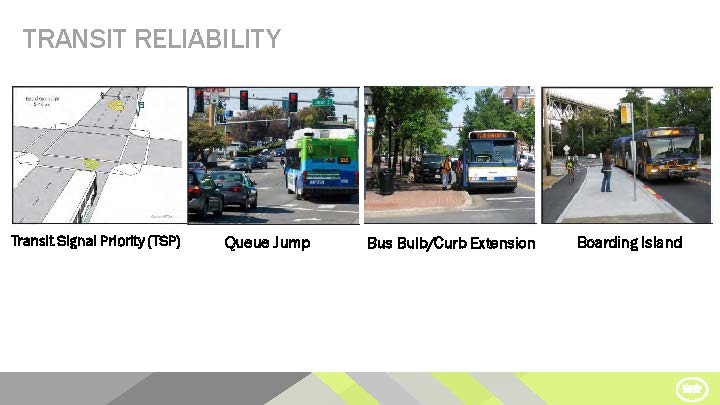
Bus Rapid Transit (BRT) is dead for now, but individual cites in their El Camino Specific Plan are still looking at use of the above approaches selectively. Transit Signal Priority technology may turn a traffic light green early in order to allow an approaching express bus to NOT stop or slow.
Which Transit gets Priority
Another challenge — we are still going to be negotiating space along the El Camino Real roadway whether it is for bikes, parking, transit, cars, or pedestrians. I should have said pedestrians bikes, transit [audience laughter].
The Emergence of New Voting Constituencies
As we see more and more people moving into the El Camino, it’s going to build its own constituency, the way Mountain View has a bicycle constituency now. We were stunned at the first Mountain View engagement meetings when biking fans said we really need to have bike lanes on El Camino. Everybody thought that wasn’t going to happen on El Camino.
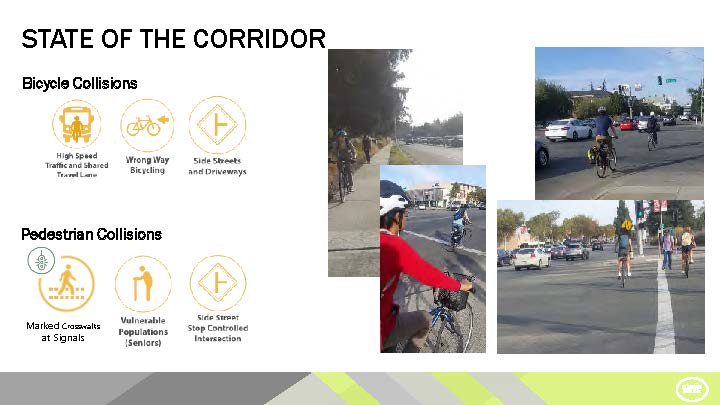
Bikes struggle for priority on El Camino. In MV bicyclists are an active constituency asking for a safer El Camino ride.
Achieve the GBI without BRT as a first mover
I really think the Grand Boulevard Initiative (GBI) is going to come to fruition at least as quickly as if the VTA had just done a light rail line or BRT up and down the El Camino for 50 miles. There are 25 different jurisdictions that all have to say yes to that. I think each one is going to say Yes in their own way because they are going to be pressured by the people voting for city councils. And those people are going to be the new people who live along El Camino that say this is my backyard too and I want to have access to transit and bicycling and a quality pedestrian experience with good public spaces. So they are going to have an expectation that this isn’t a state highway anymore. It’s going to be their next generation of Main Street.
The new voting constituency will see El Camino as their Main Street
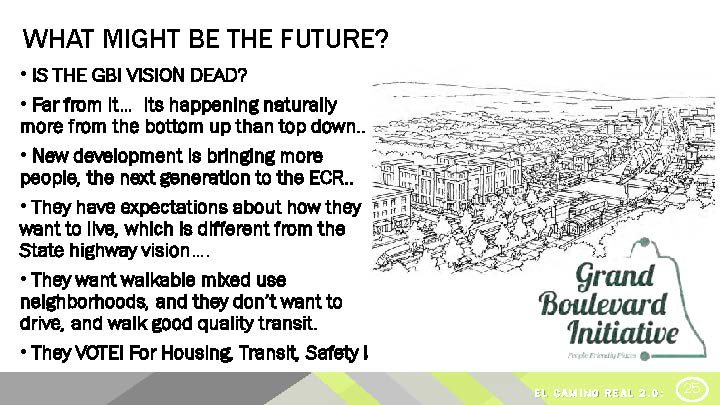
“El Camino will become more and more people’s Main Street, back yard, etc. They will be a growing constituency.” Rick Williams
Next Gen really is Different
When I listen to my son, he is telling me he wants to live in a walkable neighborhood. He doesn’t want to drive. It took him till he was 19 or 20 to get a driver’s license. “I just want to take transit. I want to walk to work. I want to walk to the coffee shop, walk to my shopping.”
You know eventually, we’re going to be gone. [the grey-haired ones]. And they are all going to be voting. So for the politicians in the room – think of your future. It will be prioritized by housing, transit, bikes, safety and a lot of new residents that are going to have that shared value system.
Assisted Living Affordable Housing
“And to add to that, there are a couple of special groups we need to listen to even more.”
Rick Williams introduced Jan Stokey, Head of “Housing Choices, ” a non-profit advocate for assisted living housing for developmentally handicapped adults.

Developmentally Disabled Housing is a good use of the very small parcels along El Camino. As small biz owners retire and sell their parcels, more of these could be built over time.
Here Lalahpolitico’s synopsis of Stokley’s talk:
Housing Element Law requires a developer to provide only for the physically handicapped adults, whereas the developmentally handicapped are not included in that law.
Although the developmentally handicapped adults can qualify for significant services from the County, there is no safety net for their housing. When the parents of such an adult have passed away, the adult child needs a place to live that provides some assistance. Many have jobs and can take transit alone. But they do need assistance. What they don’t need is any parking spaces! A new 15-unit project on El Camino for this transit-dependent population has just 6 spaces. 2 for the building manager. 4 shared.
What the developmentally disabled don’t need is any parking spaces! They are a transit-dependent population. Perfect neighbors for SFH neighborhoods. – Jan Stokley
Per Stokley, small parcels on El Camino are perfect for small housing projects providing assisted living housing to developmentally disabled adults. The residents have easy access to transit. She hopes that every El Camino Specific Plan area will have plenty of Market Rate Housing as well. That will attract the development of new kinds of “retail nodes” to El Camino. She agrees the old pattern of linear retail is on its way out.

While driving on El Camino around here, you may have noticed the building at the left. It is near the Miramonte x El Camino intersection Lalahpolitico believes. Small sites in a city’s El Camino Specific Plan are a good fit for so-called “inclusive housing.” This one is for developmentally disabled adults. They rely on transit, and don’t drive and don’t need any parking. Perfect neighbors for SFH neighborhoods.
A couple of Audience Questions
with Rick Williams’s answers
1) How soon can El Camino become more bicycle friendly, especially with protected bike lanes?
Rick Williams- Van Meter William Pollack LLP: Certain sections of El Camino have lots of curb cuts that interfere with a bike lane. In those areas, the businesses are extremely reluctant to give up those curb cuts which provide ingress and egress to their own property. Each of the small parcels may have at least one curb cut. If you are on a protected bike lane, and then all of a sudden it isn’t protected…you need to design in a lot of transition space…for those turns into a driveway … it’s hard. In San Francisco on the Embarcadero, some sections of the road are protected, some are semi-protected, some not at all.
To the extent, you are adding residents to El Camino, and they have bikes, you are building an even larger constituency for better biking. They will be asking for more protection. And as the small parcels get sold by retiring small businesses, the city can require fewer curb cuts. The Grand Boulevard is going to take another 30 years.
2) What with the cost of developable land what it is, how do developers put pro-formas together to make it work? The only thing I can see is you need 250 to 300 units and lots of density, and you need a very high rent! How does this square with providing affordable housing?
Eric Anderson with the Planning Department of Mountain View: Cities do feasibility Analysis. Suppose there is an economically underperforming site at its current level of development. We know there are competing uses for that site.
But in terms of preventing an AH project, we do an analysis of what % of BMR still makes the project feasible at an expected rate of return.- Eric Robertson MV Planner
Rick Williams: We work with economic consultants, See the Echo 2 project, for a summary of that economic analysis. One of the things that cities need to do – we worked extensively in MV with Eric on this – is we define the issues of density around the building envelope you’re allowed to build within. Then the density is less important within that envelope. So you the developer can put in whatever number of units you want in some cases. As long as you fit within the envelope of the general zoning regulations.
I will use Palo Alto as an example. When we evaluated their city zoning many years ago, we told them your density is too low for the size of land. It was creating units that were too spacious. For example, if you – the developer – have a 10,000 sq ft. parcel and you could only put 4 units on it in a mixed-use project, but you had a FAR of 1.0. Each of your 4 units would be 2,500 square feet and $7500 a month. Such a unit is going to be really expensive to build, buy or rent.
Image: Mountain View

Circa May 2019. Status of the Mountain View El Camino Specific Plan – what’s completed, what’s in planning along the MV parts of El Camino.
Image: Los Altos

Circa Jan 2018 – City of Los Altos map showing Mountain View zoning intensity (colored blocks) as prescribed by it El Camino Specific Plan and MV gray parcels… across from the City of Los Altos side of El Camino show as white parcels
Rick Williams continues…
This applies to any development, not just in an El Camino Specific Plan area.
A developer wants to max out the floor area ratio they can build. If you are going to use density as a measuring stick of the worth of a project, you have to tie the density to your overall building envelope, such that you get the unit sizes such that you will get a variety of different rents. You need to have the ability to have studios, 1 bedroom, 2 bedrooms and a mix that will create a proforma that kind of works.
Cities need to look at housing, how much density, or preferably how many AH units are required.
Most of the cities are now looking at their commercial development and saying you can’t just build jobs. You also have to build housing. They may have a housing-jobs linkage fee. So those commercial projects are contributing money to a housing fund. And the city is using that fund to leverage their dollars with State tax credits, Federal tax credits, and other funding sources to gain more AH typically developed by non- profits and some for-profits that do AH as well. As a shared community goal, a lot of the money that comes into Mountain View’s housing coffer isn’t owed just from housing developers but also from commercial developers.
In San Francisco the City has decided that there has been so much land value escalation, that people have been sitting on the land for so long, it’s just such a huge windfall gain, that they really didn’t earn, they just happened to buy the land 15 or 20 years ago. And the City is literally doing an evaluation – this is a little crass – they are calculating, aka doing the mathematical pro forma to figure out how large a pound of flesh they can take, that lowers the property value for a piece of land. So that the City can say well, maybe we can ask for 20% affordable housing? They got some pushback at 25%, so they dropped it to 18%, and then they are incrementally increasing it up to 20% to 23% and 25% in a few years.
They are saying, you know just because you bought that property in 1975, doesn’t mean you really earned all that land value. So part of that is going to go back into the City’s housing coffer. So they are a little more draconian about it.
And other communities are saying jobs also create a housing problem – so we are going to ask the commercial community to also be part of the housing solution.
All of those are parts of the Housing Element chapter of the General Plan in each city. They are all trying to figure out various ways to generate AH.

Remember when this restaurant building on El Camino near El Monte was some kind of steak house? It has stood vacant for a decade? Now replaced with housing as shown.
The Odd Case Of Santa Rosa
Rick Williams: In Santa Rosa, the sad fact is that because of the fires they want a lot of housing, and they are having to evaluate a whole series of policy issues.
They wanted a lot of housing in their downtown, and they aren’t getting it. They are thinking of holding off on their AH housing requirement (Inclusionary % BMR) for 3 years, aka for putting a moratorium on it. That change would maybe get some significant 100% Market Rate Housing downtown. All they have gotten has been a small amount of housing and a small amount of BMRs.
“We are going to give you developers three years to get your Market Rate project done. Then the inclusionary BMR % will kick back in.” They want to expedite JUST GETTING MORE HOUSING BUILT. The City really want to get some Market Rate housing in a short time frame.
Santa Rosa changed their policy, their fee structure, and everything because that City is not in the same economic situation where Mountain View is… where the development community just can’t build it fast enough. In Santa Rosa, they can’t get anything to pencil out. So they are cutting the fees, cutting the time, they have eliminated the design review committee. They said we need more housing now. They lost a lot in the fires. They are literally just trying to jumpstart housing development. It may be for a very short time at the sacrifice of Affordable Housing expansion.
Resources:
Definition: There is no difference between a Specific Plan and a Precise Plan. These terms are used as synonyms.
Here is a prior post about the issues with the City of Los Altos El Camino CT Zone. It explains the non-compliance of the City with HCD requirements.
Van Meter Williams Pollack LLP website. Williams mentioned an example of a pro forma analysis called Echo 2, but I did not discover it in a web search.
Housing Choices – Jan Stokley, assisted living for the developmentally disabled.



